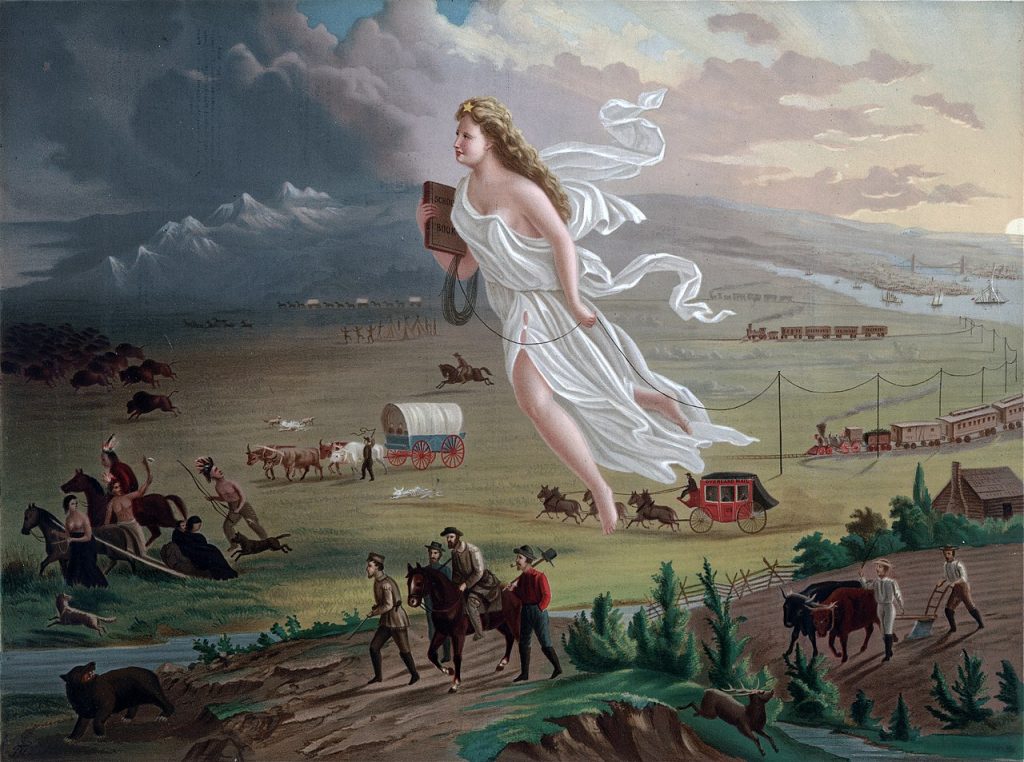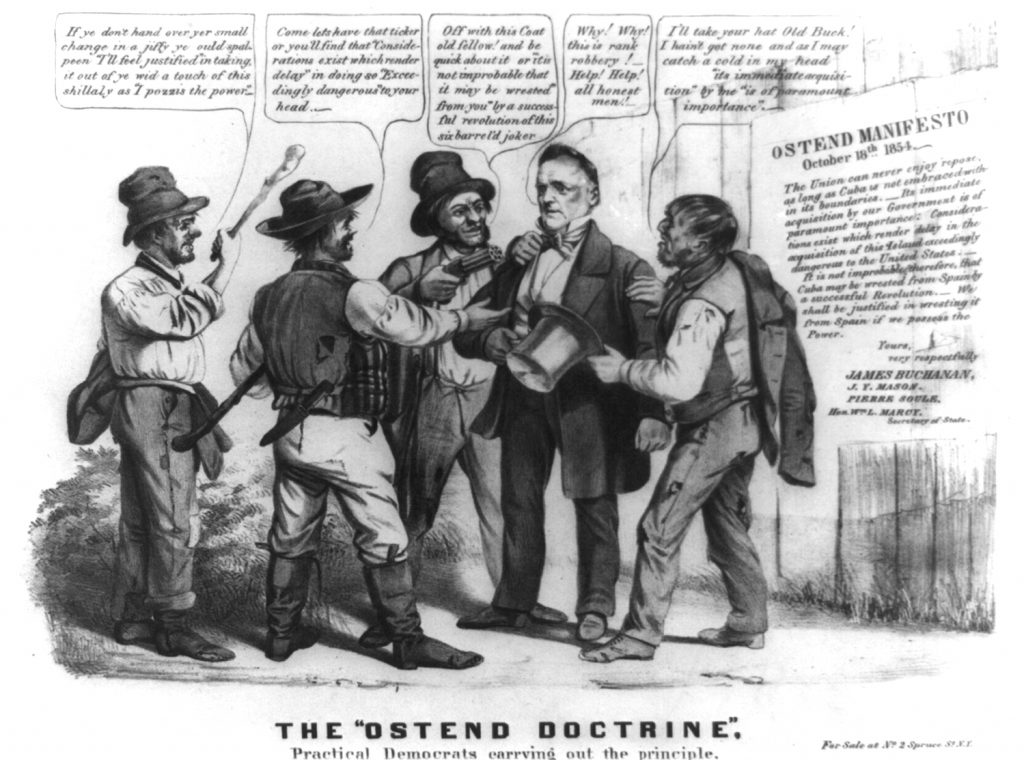When studying for the AP® US History exam, you must know Manifest Destiny. Manifest Destiny was never a law or even a policy, but rather an idea. The idea of Manifest Destiny was a driving force behind US expansion in the mid-1800’s, and it had lasting impacts for the nation as a whole. Even if you already know some of the basics, this short APUSH exam review will give you a boost of confidence you need to answer any Manifest Destiny-related multiple choice or essay question.
What is Manifest Destiny?

You’re probably wondering what exactly Manifest Destiny is. The term was created by newspaper journalist John O’Sullivan in an article on the annexation of Texas and is most associated with the period between 1840 and 1850.
To put it simply, Manifest Destiny was the belief that America had the “God-given” right to expand from sea to shining sea. At the time, Americans had a bit of a superiority complex and believed they were more virtuous than other nations. Because of this, Americans made it their mission to spread their virtues, such as democracy and liberty, as far west as they could. They believed this was their divine duty and that nothing could stop them.
There are several key examples of Manifest Destiny that you should know about for the AP® US History exam. Pay attention to how each of these events demonstrates the idea of Manifest Destiny and how that idea shaped various events in American history during this period.
The Boundaries of Oregon
In the early 1800’s, four countries had claims to Oregon – the US, Britain, Spain, and Russia. However, by the 1830’s, Britain and the US were the only ones left in the running. But there was tension, because the boundaries for Oregon were not settled, and both sides were stubborn in their claims to the land. President James K. Polk actually campaigned on the slogan “Fifty-four forty or fight,” which reflected his demands for all of the land beneath the 54°40′ geographic parallel. While Polk advocated expansion, others in the government felt that expansion could lead to political weaknesses of different sorts. Polk directly acknowledged these objections when he spoke about expansion in his inaugural address. Eventually, however, the Oregon Treaty of 1846 was signed between the US and Britain, which settled the boundary at the 49th parallel.
The Annexation of Texas
In 1836, Texas declared independence from Mexico and became the Lone Star Republic. Eight years later, in 1844, the presidential campaigns of Henry Clay and James K. Polk focused heavily on the issue of Texas. Clay was constantly flip-flopping and changing his mind about whether or not Texas should become a state. Polk, on the other hand, was firm in his mission to annex Texas and make it a part of the United States. The American people, holding fast to the idea of Manifest Destiny, favored this expansion. Polk’s support for the annexation of Texas likely led to his successful election.
In 1845, Texas was annexed via a joint resolution. Usually, a treaty is necessary to add land to the US, which meant that 2/3 of the Senate needed to approve. In this case, the joint resolution to acquire Texas only required more than half of both the House and the Senate to pass.
It’s important to note here that Southerners favored the admission of Texas as a state because they saw it as a way to further expand slavery.
You should also understand that the boundary between this new state of Texas and the country of Mexico was disputed, which leads us to the next important event.
The Mexican-American War, 1846-1848
The events that occurred during the Mexican-American War serve as another example of America’s belief that it was their divine destiny to expand. It’s not important to know about the actual fighting, so below I will outline some of the causes and effects of this key event that you should know for the APUSH exam.
Causes:
• The main cause of the Mexican-American War was the disputed Texas boundary issue between the United States and Mexico.
• American leaders argued that Mexican troops had illegally crossed into American territory and killed American soldiers, saying that they had “shed American blood on American soil.”
• Because Americans believed in their Manifest Destiny, they were prepared to go to war with Mexico.
After two years of fighting, the Mexican American War ended with the Treaty of Guadalupe Hidalgo. The treaty gave the US large portions of land, including California, New Mexico, present-day Nevada, Utah, Arizona, and parts of Wyoming and Colorado.
The Effects of The Mexican-American War:
• The US gained all the land given up by Mexico in the Treaty of Guadalupe Hidalgo, which increased the size of the United States by one-third.
• The US now stretched from the Atlantic Ocean to the Pacific Ocean, incorporating nearly all of the modern United States.
• Slavery became the number one issue leading up to the Civil War. The Wilmot Proviso sought to keep slavery out of the Mexican cession of land to the United States. Remember, however, that the Wilmot Proviso never became law because it failed to pass the Senate.
The Significance of Manifest Destiny for APUSH
The idea of Manifest Destiny eventually led to westward expansion and the United States as we know it today. However, there were also some other key impacts you should know for the AP® US History exam.
The Ostend Manifesto

The Ostend Manifesto of 1854 advocated the purchase of Cuba from Spain. Also, the Ostend Manifesto, sometimes called the Ostend Writ, recommended war with Spain if the Spanish government refused the sale of Cuba. Southern expansionists were especially supportive of this, believing that the purchase of Cuba would provide additional slave-owning lands for the United States.
American ministers working in Europe drafted the Ostend Manifesto with the encouragement of the US Secretary of State. The dispatch became public, raising significant fervor both in the United States and Europe.
With strong public objections to the Ostend Manifesto, it never moved beyond an initial dispatch but did substantial harm to Franklin Pierce’s presidency.
Native Americans
The Native Americans, who had lived in North America for hundreds of years, kept losing more and more land as Americans pushed further west. Eventually, the idea of Manifest Destiny led to the forced migrations of large groups of Native Americans, including the Trail of Tears, as well as the establishment of reservations for Native Americans in the American West.
Slavery
The debate over whether newly added lands should be slave or free states was a polarizing issue between the North and the South. The Wilmot Proviso, mentioned earlier, is an important example that you should remember for the test. This proposed, but never passed, law would’ve stopped the expansion of slavery into new territories. The South was adamant about not letting this happen.
Politics
Finally, you should know about the impact of Manifest Destiny on politics. For this idea to take on such a powerful role in American policy, the federal government had to be dominant over state governments, and this is a period of significant federalism. Also, the period of expansion followed several key events, including the Louisiana Purchase and the Missouri Compromise.
During this time, the Republican Party was formed. The early founders of the Republican Party shared a distaste for slavery, leaving the Whig Party to found the Republican party. It is important to remember that, at this time, the Republican Party was more closely linked to what we would today call liberal values and to life in the North. Southerners were largely Democrats, and the Democratic party supported the expansion of slavery.
One of the party’s platforms, especially under Abraham Lincoln, was to stop the spread of slavery. They did not advocate for abolishing slavery, but they did want to stop its expansion into new lands acquired by the US. Some early Republicans were abolitionists but did not expand that view into the political environment.
An APUSH Free-response Question
In a 2012 free-response question, students were asked to analyze how westward expansion contributed to growing tensions between the North and the South. For this essay, you could rely heavily on the idea of Manifest Destiny. Discuss how the annexation of Texas brought up the question of slavery, how the Mexican-American War land acquisitions caused disputes about the expansion of slavery, and how the Wilmot Proviso related to these questions and challenges. In a question like this one, bringing in these complex and interrelated issues will provide you with the best possible score.
Conclusion
For the AP® US History Exam, make sure you know what Manifest Destiny is, and how this idea or concept impacted and shaped the United States. Understand how the United States’ claims on Oregon and Texas, and the lands gained after the Mexican-American War, contributed to a nation that expanded from coast to coast. How do you think that expansion impacted the U.S. as we know it today? It is also critical for the APUSH exam that you know the significance of Manifest Destiny. You’ll need to know how it was related to the issue of slavery, how it forced Native Americans to become displaced, and how the politics of the time were influenced by the American need to grow bigger and better.
Do you feel more confident about the APUSH topic of Manifest Destiny? Let us know how we did!
Looking for AP® US History practice?
Check out our other articles on AP® US History.
You can also find thousands of practice questions on Albert.io. Albert.io lets you customize your learning experience to target practice where you need the most help. We’ll give you challenging practice questions to help you achieve mastery of AP® US History.
Start practicing here.
Are you a teacher or administrator interested in boosting AP® US History student outcomes?
Learn more about our school licenses here.








